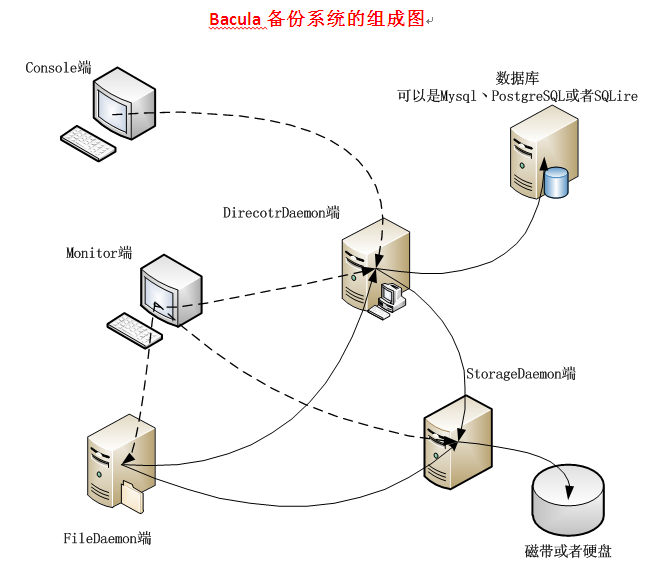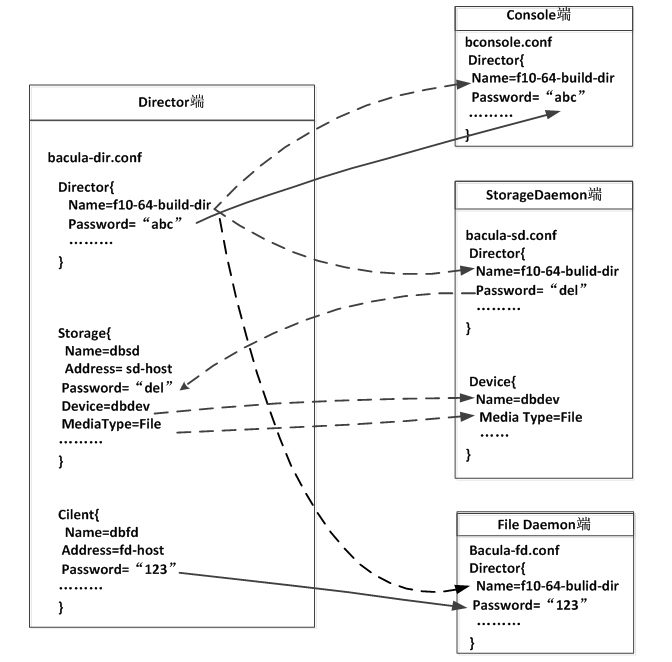bacula备份工具
源码下载:http://www.bacula.org
bacula适合数据业务量巨大,每天都在迅速增长,还需要以tar打包方式进行低级备份而且没有异地容灾策略。Bacula是一个完美的增量备份功能,同时还支持远程容灾备份,可以通过bacula,可以将数据备份到任意一个远程的主机上
1. 安装
# yum -y install mysql-devel.x86_64 //依赖头文件,可以看configure
# ./configure \--sbindir=/opt/bacula/bin \--sysconfdir=/opt/bacula/etc \--enable-smartalloc \--with-mysql \--with-working-dir=/opt/bacula/working \--with-pid-dir=/opt/bacula/working \--with-subsys-dir=/opt/bacula/working \--with-plugindir=/usr/lib64出现错误:configure: error: Unable to find a working C++ compiler# yum install gcc-c++.x86_64 //redhat# apt-get install g++ //ubuntu
sbindir:bin文件
sysconfdir:脚本和配置文件
libdir:libraries文件
mysql:检查mysql头文件
plugindir:Bacula plugins directory
2. 配置文件
/opt/bacula/etc目录
3. 初始化Mysql数据库
在baculaServer上安装完bacula后,还需要创建bacula对应的Mysql数据库以及访问数据库的授权,好在bacula已经为用户准备好了这样的脚本,接下来只要在bacula服务器端上执行如下脚本即可
# cd /bacula/etc# ./grant_mysql_privileges# ./create_mysql_database# ./make_mysql_tables
这些脚本需要mysql这个命令,默认在/usr/bin目录下
脚本中是这样写的:
bindir=/var/lib/mysql/bin
接下来可以登录Mysql数据库,查看bacula的数据库和数据表是否已经建立。在执行上面三行Mysql初始代码时,默认由空密码的root用户执行,因此要请确保Mysql数据库root密码为空
4. 配置bacula备份系统
Director Daemon:负责监听所有的备份、恢复、验证、存档事务,以及定制备份和恢复文件计划等,并将整个系统运行状况记录在一个数据库文件中。其配置文件为bacula-dir.conf
Storage Daemon(SD):主要负责将数据备份到存储介质上,而在数据恢复时,负责将数据从存储介质中传送出去。其配置文件为bacula-sd.conf
File Daemon(FD):安装在需要备份数据的机器上的守护进程,在备份数据时,它负责把文件传出,在恢复数据时负责接收数据并执行恢复操作。配置文件为bacula-fd.conf
Console:管理控制台。可以通过这个控制台连接到Director Daemon进行管理备份与恢复操作
Monitor:进程监控端
1. 配置bacula的Console端
Console端的配置文件是bconsole.conf
Director {Name = f10-64-build-dir #控制端名称,在下面的bacula-dir.conf和bacula-sd.conf文件中会陆续的被引用DIRport = 9101 #控制端服务端口address = 192.168.12.188 #控制端服务器IP地址Password = "ouDao0SGXx/F+Tx4YygkK4so0l/ieqGJIkQ5DMsTQh6t" #控制端密码文件}
2. 配置bacula的Director端
bacula-dir.conf是Director端的配置文件,也是bacula的核心配置文件,这个文件非常复杂,共分为10个逻辑段,分别是:
- Director,定义全局设置
- Catalog,定义后台数据库
- Jobdefs,定义默认执行任务
- Job,自定义一个备份或者恢复任务
- Fileset,定义备份哪些数据,不备份哪些数据
- Schedule,定义备份时间策略
- Pool,定义供Job使用的池属性
- Client,定义要备份的主机地址
- Storage,定义数据的存储方式
- Messages,定义发送日志报告和记录日志的位置
Director { #定义bacula的全局配置Name = f10-64-build-dirDIRport = 9101 #定义Director的监听端口QueryFile = "/opt/bacula/etc/query.sql"WorkingDirectory = "/opt/bacula/var/bacula/working"PidDirectory = "/var/run"Maximum Concurrent jobs = 1 #定义一次能处理的最大并发数#验证密码,这个密码必须与bconsole.conf文件中对应的Director逻辑段密码相同Password = "ouDao0SGXx/F+Tx4YygkK4so0l/ieqGJIkQ5DMsTQh6t"#定义日志输出方式,"Daemon"在下面的Messages逻辑段中进行了定义Messages = Daemon}Job { #自定义一个备份任务Name = "Client1" #备份任务名称。如果有空格,字符串需要用双引号Client = dbfd #指定要备份的客户端主机,"dbfd"在后面Client逻辑段中进行定义Level = Incremental #定义备份的级别,Incremental为增量备份。Level的取值#可为Full(完全备份)、Incremental(增量备份)#和Differential(差异备份),如果第一次没做完全备份,则先进行完全备份后再执行Incrementaltype = Backup #定义Job的类型,"backup"为备份任务,可选的类型还有restore和verify等FileSet = dbfs #指定要备份的客户端数据,"dbfs"在后面FileSet逻辑段中进行定义Schedule = dbscd #指定这个备份任务的执行时间策略,"dbscd"在后面的Schedule逻辑段中进行了定义Storage = dbsd #指定备份数据的存储路径与介质,"dbsd" 在后面的Storage逻辑段中进行定义Messages = StandardPool = dbpool #指定备份使用的pool属性,"dbpool"在后面的Pool逻辑段中进行定义。write Bootstrap = "/opt/bacula/var/bacula/working/Client2.bsr" #指定备份的引导信息路径}Job { #定义一个名为Client的差异备份的任务Name = "Client"Type = BackupFileSet = dbfsSchedule = dbscdStorage = dbsdMessages = StandardPool = dbpoolClient = dbfdLevel = Differential #指定备份级别为差异备份Write Bootstrap = "/opt/bacula/var/bacula/working/Client1.bsr"}Job { #定义一个名为BackupCatalog的完全备份任务Name = "BackupCatalog"Type = BackupLevel = Full #指定备份级别为完全备份Client = dbfdFileSet="dbfs"Schedule = "dbscd"Pool = dbpoolStorage = dbsdMessages = StandardRunBeforeJob = "/opt/bacula/etc/make_catalog_backup bacula bacula"RunAfterJob = "/opt/bacula/etc/delete_catalog_backup"Write Bootstrap = "/opt/var/bacula/working/BackupCatalog.bsr"}Job { #定义一个还原任务Name = "RestoreFiles"Type = Restore #定义Job的类型为"Restore ",即恢复数据Client=dbfdFileSet=dbfsStorage = dbsdPool = dbpoolMessages = StandardWhere = /tmp/bacula-restores #指定默认恢复数据到这个路径}FileSet { #定义一个名为dbfs的备份资源,也就是指定需要备份哪些数据,需要排除哪些数据等,可以指定多个FileSetName = dbfsInclude {Options {signature = MD5; Compression=gzip; } #表示使用MD5签名并压缩file = /cws3 #指定客户端FD需要备份的文件目录}Exclude { #通过Exclude排除不需要备份的文件或者目录,可根据具体情况修改File = /opt/bacula/var/bacula/workingFile = /tmpFile = /procFile = /tmpFile = /.journalFile = /.fsck}}Schedule { #定义一个名为dbscd的备份任务调度策略Name = dbscdRun = Full 1st sun at 23:05 #第一周的周日晚23:05分进行完全备份Run = Differential 2nd-5th sun at 23:05 #第2~5周的周日晚23:05进行差异备份Run = Incremental mon-sat at 23:05 #所有周一至周六晚23:05分进行增量备份}FileSet {Name = "Catalog"Include {Options {signature = MD5}File = /opt/bacula/var/bacula/working/bacula.sql}}Client { #Client用来定义备份哪个客户端FD的数据Name = dbfd #Clinet的名称,可以在前面的Job中调用Address = 192.168.12.189 #要备份的客户端FD主机的IP地址FDPort = 9102 #与客户端FD通信的端口Catalog = MyCatalog #使用哪个数据库存储信息,"MyCatalog"在后面的MyCatalog逻辑段中进行定义Password = "ouDao0SGXx/F+Tx4YygkK4so0l/ieqGJIkQ5DMsTQh6t" #Director端与客户端FD的验证密码,#这个值必须与客户端FD配置文件bacula-fd.conf中密码相同File Retention = 30 days #指定保存在数据库中的记录多久循环一次,这里是30天,只影响数据库中的记录不影响备份的文件Job Retention = 6 months #指定Job的保持周期,应该大于File Retention指定的值AutoPrune = yes #当达到指定的保持周期时,是否自动删除数据库中的记录,yes表示自动清除过期的Job}Client {Name = dbfd1Address = 192.168.12.188FDPort = 9102Catalog = MyCatalogPassword = "Wr8lj3q51PgZ21U2FSaTXICYhLmQkT1XhHbm8a6/j8Bz"File Retention = 30 daysJob Retention = 6 monthsAutoPrune = yes}Storage { # Storage用来定义将客户端的数据备份到哪个存储设备上Name = dbsdAddress = 192.168.12.188 #指定存储端SD的IP地址,不要用localhost,不然异机会连接不上SDPort = 9103 #指定存储端SD通信的端口Password = "ouDao0SGXx/F+Tx4YygkK4so0l/ieqGJIkQ5DMsTQh6t" #Director端与存储端SD的验证密码,#这个值必须与存储端SD配置文件bacula-sd.conf中Director逻辑段密码相同Device = dbdev #指定数据备份的存储介质,必须与存储端(这里是192.168.12.188)的bacula-sd.conf配置文件中的#"Device" 逻辑段的"Name"项名称相同Media Type = File #指定存储介质的类别,必须与存储端SD(这里是192.168.12.188)的bacula-sd.conf配置文件中的#"Device" 逻辑段的"Media Type"项名称相同}Catalog { # Catalog逻辑段用来定义关于日志和数据库设定Name = MyCatalogdbname = "bacula"; dbuser = "bacula"; dbpassword = "" #指定库名、用户名和密码}Messages { # Messages逻辑段用来设定Director端如何保存日志,以及日志的保存格式,可以将日志信息发送到管理员邮箱,# 前提是必须开启sendmail服务Name = Standardmailcommand = "/usr/sbin/bsmtp -h localhost -f \"\(Bacula\) \<%r\>\" -s \"Bacula: %t %e of %c %l\" %r"operatorcommand = "/usr/sbin/bsmtp -h localhost -f \"\(Bacula\) \<%r\>\" -s \"Bacula: Intervention needed for %j\" %r"mail = dba.gao@gmail.com = all, !skippedoperator = exitgogo@126.com = mountconsole = all, !skipped, !savedappend = "/opt/bacula/log/bacula.log" = all, !skipped #定义bacula的运行日志append ="/opt/bacula/log/bacula.err.log" = error,warning, fatal #定义bacula的错误日志catalog = all}Messages { #定义了一个名为Daemon的Messages逻辑段,"Daemon"已经在前面进行了引用Name = Daemonmailcommand = "/usr/sbin/bsmtp -h localhost -f \"\(Bacula\) \<%r\>\" -s \"Bacula daemon message\" %r"mail = exitgogo@126.com = all, !skippedconsole = all, !skipped, !savedappend = "/opt/bacula/log/bacula_demo.log" = all, !skipped}Pool { #定义供Job任务使用的池属性信息,例如,设定备份文件过期时间、是否覆盖过期的备份数据、是否自动清除过期备份等Name = dbpoolPool Type = BackupRecycle = yes #重复使用AutoPrune = yes #表示自动清除过期备份文件Volume Retention = 7 days #指定备份文件保留的时间Label Format ="db-${Year}-${Month:p/2/0/r}-${Day:p/2/0/r}-id${JobId}" #设定备份文件的命名格式,#这个设定格式会产生的命名文件为:db-2010-04-18-id139Maximum Volumes = 7 #设置最多保存多少个备份文件Recycle Current Volume = yes #表示可以使用最近过期的备份文件来存储新备份Maximum Volume Jobs = 1 #表示每次执行备份任务创建一个备份文件}Console { #限定Console利用tray-monitor获得Director的状态信息Name = f10-64-build-monPassword = "RSQy3sRjak3ktZ8Hr07gc728VkZHBr0QCjOC5x3pXEap"CommandACL = status, .status}
3. 配置bacula的SD(备份目的)
SD的配置文件是bacula-sd.conf
Storage { #定义存储,本例中是f10-64-build-sdName = f10-64-build-sd #定义存储名称SDPort = 9103 #监听端口WorkingDirectory = "/opt/bacula/var/bacula/working"Pid Directory = "/var/run"Maximum Concurrent Jobs = 20}Director { #定义一个控制StorageDaemon的DirectorName = f10-64-build-dir #这里的"Name"值必须和Director端配置文件bacula-dir.conf中Director逻辑段名称相同Password = "ouDao0SGXx/F+Tx4YygkK4so0l/ieqGJIkQ5DMsTQh6t" #这里的"Password"值必须和Director端配置文件#bacula-dir.conf中Storage逻辑段密码相同}Director { #定义一个监控端的DirectorName = f10-64-build-mon #这里的"Name"值必须和Director端配置文件bacula-dir.conf中Console逻辑段名称相同Password = "RSQy3sRjak3ktZ8Hr07gc728VkZHBr0QCjOC5x3pXEap" #这里的"Password"值必须和Director端配置文件#bacula-dir.conf中Console逻辑段密码相同Monitor = yes}Device { #定义DeviceName = dbdev #定义Device的名称,这个名称在Director端配置文件bacula-dir.conf中的Storage逻辑段Device项中被引用Media Type = File #只要和Storage -> Media type名字一致即可Archive Device = /webdata #Archive Device用来指定备份存储的介质,可以是cd、dvd、tap等,#这里是将备份的文件保存的/webdata目录下LabelMedia = yes; #通过Label命令来建立卷文件Random Access = yes; #设置是否采用随机访问存储介质,这里选择yesAutomaticMount = yes; #表示当存储设备打开时,是否自动使用它,这选择yesRemovableMedia = no; #是否支持可移动的设备,如tap或cd,这里选择noAlwaysOpen = no; #是否确保tap设备总是可用,这里没有使用tap设备,因此设置为no}Messages { #为存储端SD定义一个日志或消息处理机制Name = Standarddirector = f10-64-build-dir = all}
4. 配置bacula的FD端(备份源)
客户端FD运行在一台独立的服务器上,它的配置文件是bacula-fd.conf
Director { #定义一个允许连接FD的控制端Name = f10-64-build-dir #这里的"Name"值必须和Director端配置文件bacula-dir.conf中Director逻辑段名称相同Password = "ouDao0SGXx/F+Tx4YygkK4so0l/ieqGJIkQ5DMsTQh6t" #这里的"Password"值必须和Director端配置文件#bacula-dir.conf中Client逻辑段密码相同}Director { #定义一个允许连接FD的监控端Name = f10-64-build-monPassword = "RSQy3sRjak3ktZ8Hr07gc728VkZHBr0QCjOC5x3pXEap"Monitor = yes}FileDaemon { #定义一个FD端Name = localhost.localdomain-fdFDport = 9102 #监控端口WorkingDirectory = /opt/bacula/var/bacula/workingPid Directory = /var/runMaximum Concurrent Jobs = 20 #定义一次能处理的并发作业数}Messages { #定义一个用于FD端的MessagesName = Standarddirector = localhost.localdomain-dir = all, !skipped, !restored}
借用一个图:
5. 启动bacula的Director daemon与Storage daemon
第一种方式:
# /opt/bacula/sbin/bacula {start|stop|restart|status}
第二种方式:
# /bacula/etc/bacula-ctl-dir {start|stop|restart|status}# /bacula/etc/bacula-ctl-sd {start|stop|restart|status}# /bacula/etc/bacula-ctl-fd {start|stop|restart|status}
观察启动端口情况:
# netstat -antl | grep 91tcp 0 0 0.0.0.0:9101 0.0.0.0:* LISTENtcp 0 0 0.0.0.0:9102 0.0.0.0:* LISTENtcp 0 0 0.0.0.0:9103 0.0.0.0:* LISTEN
注:启动bacula的dir服务前,必须启动MySQL数据库
6. 在客户端FD启动File daemon
# /bacula/sbin/bacula {start|stop|restart|status}
# /bacula/etc/bacula-ctl-fd {start|stop|restart|status}
7. 工作流程
- 通过console连接到Director端,备份恢复操作开始
- Director端从自己的数据库中调出记录信息,对存储端SD与客户端FD的任务进行协调
- 客户端FD负责验证Director的操作许可,如果验证通过,则允许连接到存储端SD
- 客户端FD根据Director发出的请求去连接SD,将FD端的数据备份到存SD指定的存储介质上,或者将SD端存储介质中的数据传回到客户端FD指定的位置上,完成备份恢复过程
8.console控制
*helpCommand Description======= ===========add Add media to a poolautodisplay Autodisplay console messagesautomount Automount after labelcancel Cancel a jobcreate Create DB Pool from resourcedelete Delete volume, pool or jobdisable Disable a job, attributes batch processenable Enable a job, attributes batch processestimate Performs FileSet estimate, listing gives full listingexit Terminate Bconsole sessiongui Non-interactive gui modehelp Print help on specific commandlabel Label a tapelist List objects from catalogllist Full or long list like list commandmessages Display pending messages //可以让作业信息立即显示memory Print current memory usagemount Mount storageprune Prune expired records from catalogpurge Purge records from catalogquit Terminate Bconsole sessionquery Query catalogrestore Restore files //还原relabel Relabel a taperelease Release storagereload Reload conf file //修改配置文件生效run Run a job //备份status Report statusstop Stop a jobsetdebug Sets debug levelsetbandwidth Sets bandwidthsetip Sets new client address -- if authorizedshow Show resource recordssqlquery Use SQL to query catalogtime Print current timetrace Turn on/off trace to filetruncate Truncate one or more Volumesunmount Unmount storageumount Umount - for old-time Unix guys, see unmountupdate Update volume, pool or statsuse Use catalog xxxvar Does variable expansionversion Print Director versionwait Wait until no jobs are runningWhen at a prompt, entering a period cancels the command.
1. 添加存储介质
# ./bconsoleConnecting to Director localhost:91011000 OK: 1 localhost-dir Version: 7.0.5 (28 July 2014)Enter a period to cancel a command.*label #run/restoreAutomatically selected Catalog: MyCatalogUsing Catalog "MyCatalog"The defined Storage resources are:1: File12: File2Select Storage resource (1-2): 1Enter new Volume name: abc #/tmp下的备份名Defined Pools:1: Default2: File3: ScratchSelect the Pool (1-3): 2Connecting to Storage daemon File at localhost:9103 ...Sending label command for Volume "abc" Slot 0 ...3000 OK label. VolBytes=192 DVD=0 Volume="abc" Device="FileChgr1-Dev1" (/tmp)Catalog record for Volume "abc", Slot 0 successfully created.Requesting to mount FileChgr1 ...3906 File device ""FileChgr1-Dev1" (/tmp)" is always mounted.*quit
2. 备份
*runAutomatically selected Catalog: MyCatalogUsing Catalog "MyCatalog"A job name must be specified.The defined Job resources are:1: BackupClient12: BackupCatalog3: RestoreFilesSelect Job resource (1-3): 1Run Backup jobJobName: BackupClient1Level: IncrementalClient: localhost-fdFileSet: Full SetPool: File (From Job resource)Storage: File (From Job resource)When: 2015-05-19 20:35:49Priority: 10OK to run? (yes/mod/no): yesJob queued. JobId=1You have messages.
3. 还原
*restoreFirst you select one or more JobIds that contain filesto be restored. You will be presented several methodsof specifying the JobIds. Then you will be allowed toselect which files from those JobIds are to be restored.To select the JobIds, you have the following choices:1: List last 20 Jobs run2: List Jobs where a given File is saved3: Enter list of comma separated JobIds to select4: Enter SQL list command5: Select the most recent backup for a client6: Select backup for a client before a specified time7: Enter a list of files to restore8: Enter a list of files to restore before a specified time9: Find the JobIds of the most recent backup for a client10: Find the JobIds for a backup for a client before a specified time11: Enter a list of directories to restore for found JobIds12: Select full restore to a specified Job date13: CancelSelect item: (1-13): 5Automatically selected Client: localhost-fdAutomatically selected FileSet: Full Set+-------+-------+----------+------------+---------------------+------------+| JobId | Level | JobFiles | JobBytes | StartTime | VolumeName |+-------+-------+----------+------------+---------------------+------------+| 1 | F | 17 | 12,840,619 | 2015-05-19 20:37:14 | Vol-0003 |+-------+-------+----------+------------+---------------------+------------+You have selected the following JobId: 1Building directory tree for JobId(s) 1 ...16 files inserted into the tree.You are now entering file selection mode where you add (mark) andremove (unmark) files to be restored. No files are initially added, unlessyou used the "all" keyword on the command line.Enter "done" to leave this mode.cwd is: /$ lsopt/$ mark opt17 files marked.$ done
中文手册:http://blog.chinaunix.net/uid/14117922/abstract/1.html
bacula备份工具的更多相关文章
- 类Unix上5个最佳开源备份工具 Bacula/Amanda/Backupninja/Backuppc/UrBackup
当为一个企业选择备份工具的时候,你都考虑什么呢? 确定你正在部署的软件具有下面的特性 开源软件 – 你务必要选择那些源码可以免费获得,并且可以修改的软件.确信可以恢复你的数据,即使是软件供应商/项目停 ...
- Linux 备份工具
Linux 备份工具 GNU 的传统备份工具 GNU tar — http://www.gnu.org/software/tar/ GNU cpio — http://www.gnu.org/so ...
- Linux和类Unix系统上5个最佳开源备份工具
一个好的备份最基本的目的就是为了能够从一些错误中恢复: 人为的失误 磁盘阵列或是硬盘故障 文件系统崩溃 数据中心被破坏等等. 所以,我为大家罗列了一些开源的软件备份工具. 当为一个企业选择备份工具的时 ...
- 超全Linux备份工具集合,满足你的所有需要!
经常备份计算机上的数据是个好的做法,它可以手动完成,也可以设置成自动执行.许多备份工具拥有不同的功能特性,让用户可以配置备份类型.备份时间.备份对象.将备份活动记入日志及执行更多操作. 1.Rsync ...
- Linux 和类 Unix 系统上5个最佳开源备份工具
转载:http://linux.cn/article-4623-weixin.html#rd?sukey=cbbc36a2500a2e6cb7678c4d38b691a9fa7403b259f898e ...
- Ubuntu系统备份工具大全(官方整理推荐)
其实官方在系统备份这块已经有Wiki整理和收集各类实用的工具.以下是翻译自官方Wiki的部分文档: 备份工具 wiki文档实用程序 工具 界面 格式类型 Raw/File 支持 远程 增量 差异 自 ...
- [转帖]服务器备份工具:Amanda,Bakula,Clonezilla,Rsnapshot,Mondo Rescue
服务器备份工具:Amanda,Bakula,Clonezilla,Rsnapshot,Mondo Rescue https://ywnz.com/linuxyffq/5270.html 改天试用一下. ...
- SQLSERVER自动定时(手动)备份工具
最近项目需要,写了一个小工具软件: 1.实时显示监控 2.可多选择备份数据库 3.按每天定时备份 4.备份文件自动压缩 5.删除之前备份文件 直接上图 1.备份监控界面: 2.数据库设置: 附工具下载 ...
- MySQL 5.7 mysqlpump 备份工具说明
背景: MySQL5.7之后多了一个备份工具:mysqlpump.它是mysqldump的一个衍生,mysqldump就不多说明了,现在看看mysqlpump到底有了哪些提升,可以查看官方文档,这里针 ...
随机推荐
- mesos-slave启动不起来
刚开始时候的状态 后来装了docker后
- 项目部署到Linux上遇到的坑
作者:晨钟暮鼓c个人微信公众号:程序猿的月光宝盒 1.本地Navicat for MySQL无法连接至服务器(Centos 7 x86_64 bbr) 1045错误: 解决步骤: 1.查看用户名密 ...
- ASP.NET Core 设置默认起始页(如default.html)
测试页面foo.html 在Startup.cs内使用middleware 代码如下: DefaultFilesOptions defaultFilesOptions = new DefaultFil ...
- 中文版 Apple 官方 Swift 教程《The Swift Programming Language》
简介 欢迎使用 Swift 关于 Swift 版本兼容性 Swift 初见 Swift 版本历史记录 Swift 教程 基础部分 基本运算符 字符串和字符 集合类型 控制流 函数 闭包 枚举 类和结构 ...
- 安装上传下载插件,jdk及redis
安装rz sz (1)编译安装root 账号登陆后,依次执行以下命令:cd /tmpwget http://www.ohse.de/uwe/releases/lrzsz-0.12.20.tar.gzt ...
- June 03rd, 2019. Week 23rd, Monday
There is no shame in hard work. 努力从来不丢人. Stop complaining about the current work arrangements, just ...
- oracle xmltype + blob + clob
oracle varchar2最大存储长度为4000,所以当字段长度超限时可尝试存储为blob或xmltype格式 xmltype --1.创建xml表 Create TABLE testxml( i ...
- Python参数类型以及实现isOdd函数,isNum函数,multi函数,isPrime函数
Python参数类型以及实现isOdd函数,isNum函数,multi函数,isPrime函数 一.Python参数类型 形参:定义函数时的参数变量. 实参:调用函数时使用的参数变量. 参数传递的过程 ...
- DirectShow 获取音视频输入设备列表
开发环境:Win10 + VS2015 本文介绍一个 "获取音频视频输入设备列表" 的示例代码. 效果图 代码下载 代码下载(VC2015):Github - DShow_simp ...
- 【STM32H7教程】第15章 STM32H7的GPIO基础知识(重要)
完整教程下载地址:http://www.armbbs.cn/forum.php?mod=viewthread&tid=86980 第15章 STM32H7的GPIO基础知识(重要) ...


